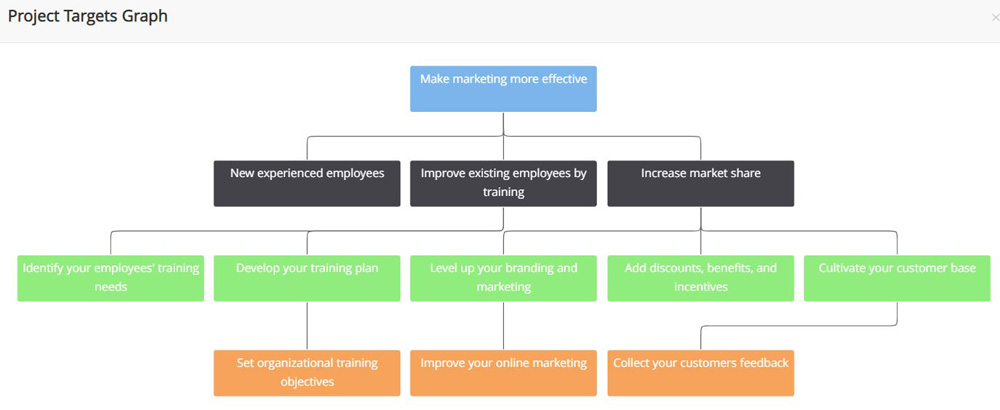Verifiable project goals are a prerequisite for project success
Clear, understandable, and verifiable goals are the primary requirements for project success. Without them, the basis for quality management has been lost.
When preparing for a project, the project goals are discussed and clarified as far as possible. The SMART rule is often used as a measure: a goal should be SMART (Specific, Measurable, Achievable, Realistic, and Time-bound).
Project goal planning is a process
It is vital that the customer and contractor develop a mutual vision of the goals, and this cannot be achieved in one meeting or several short meetings. Instead, it is a long and iterative, even incremental process.
Shared understanding is the result of a communication process among all stakeholders.
“Build me a house! Big, beautiful, environmentally friendly, and sustainable.”
For conducting a project that is interesting for all stakeholders, the qualitative goals must be determined and translated into functional goals and requirements: What does “beautiful” mean? When is a house “environmentally friendly?”
A communication process
An “iterative & incremental” communication process is needed, and there is no shortcut! It must be possible to define qualitative goals! This communication process requires pre-thought of the desired quality in the early activities of the project. Besides, you should consider measurement criteria, measurement methods, and metrics. The original question (When is the project successful?) needs to be answered before the end of the project. This process exists in quality planning. Quality planning gives you answers about how to check the quality. For this purpose, TaskBrowse has developed a module for project goal planning. Here is a screenshot of the graphical representation of the goal hierarchy. For this purpose, TaskBrowse has developed a module for project goal planning. Here is a screenshot of the graphical representation of the goal hierarchy.

This process of goal setting and determination will take place in several stages. The result will be represented as a quality target diagram in TaskBrowse.
Developed and tested in the project
This method for goal setting, which has proven itself in the project, is described by method profiles.
In short: Goal planning is an iterative process that continues into the project. At the beginning of the preparation of the project, the customer usually has a very vague understanding of the goals. Often it is only “clear” that a product has to be developed or a process has to be improved; however, the project idea is still far from clearly defined.
As the project team becomes increasingly involved with the problem space and the project requirements, the project goals become clear: a common understanding of the goals of the customer and the project team begins to take shape. This is also the result of an iterative and highly communicative process. The necessary clarity of the project goals cannot be developed only by the project management. In addition, a common understanding must be developed. And this is only possible through the communicative process of goal planning.
If this process does not succeed, the project’s success is at risk!
Target planning process
This process of goal planning is outlined as follows:
Project goals should be defined and agreed upon at the beginning of the project. For this purpose, goal planning should be done at the beginning of the project, which formulates the goals as concretely and verifiably as possible. For this purpose, an (initial) goal structure can be created. The focus should be on the formulation of quality objectives. A functional goal can be met or not, a deadline goal can be met or exceeded, and a financial goal can be met or not. A quality goal, on the other hand, is scalable; quality must be formulated in a measurable way so that the degree of goal achievement is verifiable.
Back to the initial example:
An architect receives the order “Build a house – big, beautiful …”. According to experience, he will clarify the meaning of the order and question and concretize the attributes big, beautiful, etc. On the other hand, the fact that the house should have an entrance is to be taken for granted: a door. A functional goal! Whether it is a fully automatic door, which automatically recognizes authorized users or not, is a quality goal and should be checked! The deadline and budget targets (restrictions) define the scope of a project.
Therefore, this is natural that the goals are still relatively vague at the beginning of a project. The goals will be clarified during the project’s progress.
Therefore, target planning is a tool that can be useful and applied during project implementation.
Process steps of target planning
The following process steps should be gone through (several times):
- Collect goals
- hierarchically organize, arrange, and modify goals
- formulate in an appropriate-structure way
- Show dependencies
- Prioritize goals
- Develop solution ideas
- Derive suitable measures
- Operationalize (make goals measurable)
- Planning QA and success control
- Identify risks …..
The detailed steps are described in three method profiles. In the webinar “Goal-based project planning with TaskBrowse” we presented how TaskBrowse can support you in this process from goal planning – to goal-oriented measures.
A tree structure is used as a form of representation. It is a simplification of reality – i.e. a model. However, this model reduces complexity (in a proper form) and supports the communicative process of goal setting in the team. Would you like to learn more about the possibilities of TaskBrowse?! Arrange a demo!
